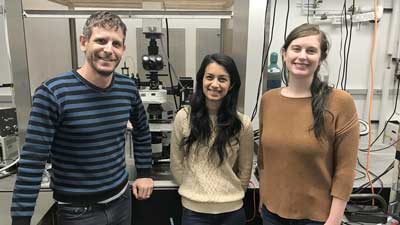| Dec 12, 2018 | |
Scientists create way to power pacemaker with light(Nanowerk News) University of Chicago scientists have pioneered a technique that could one day create a pacemaker that operates using tiny pulses of light. |
|
| “It’s essentially a tiny solar cell, which stimulates cardiac muscle in a very unique way,” said Bozhi Tian, an associate professor of chemistry who examines innovative ways to control biology with light. | |
| In a study published in the Proceedings of the Royal Academy of Sciences ("Optical stimulation of cardiac cells with a polymer-supported silicon nanowire matrix"), Tian and his team describe how they created a flexible mesh out of silicon, that when activated by flashes of light, creates a tiny electrochemical effect that encourages the heart to beat. | |
 |
|
| Key authors of the study include (from left): postdoctoral researcher Menahem Rotenberg, doctoral student Ramya Parameswaran and graduate student Kelliann Koehler. (Photo courtesy of Prof. Bozhi Tian) | |
| They started with one of their own designs previously used to stimulate neurons, but made the mesh thinner to easily wrap around the heart and strewed tiny nanowires across its surface to attach to cardiac cells. | |
| A small optical beam scans the area with a laser. Each flash activates the cells, causing the heart to beat at the same frequency as the light. (Scanning instead of directly shining on one area makes the device more efficient and avoids delivering too much energy to cells, which can damage them, Tian said.) | |
| “Unlike today’s pacemakers, this method appears to ‘train’ the cardiac muscle to beat,” Tian said. It takes awhile for the effect to kick in, but the muscles continue to fire for some time after the light pulses are stopped. | |
| The method is still early in development. If implanted in humans, the mesh could be injected at the target site, and a small optical fiber that would deliver the light pulses could be inserted through minimally invasive surgery, Tian said. |
| Source: University of Chicago | |
|
Subscribe to a free copy of one of our daily Nanowerk Newsletter Email Digests with a compilation of all of the day's news. |
